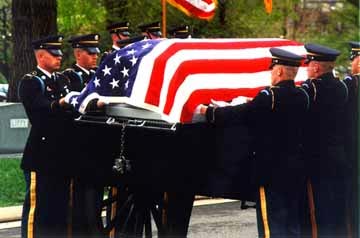Military Funeral Customs
The practice of draping the casket with the national flag:
This custom began during the Napoleonic Wars (1796-1815). The dead carried from the field of battle on a caisson were covered with flags. When the U.S. flag covers the casket, it is placed so the union blue field is at the head and over the left shoulder. It is not placed in the grave and is not allowed to touch the ground.

Flags for military funerals:
Flags are provided for burial services of service members and veterans. The flag for one who dies on active duty is provided by one’s branch of service. Flags for other veterans are provided by the Department of Veterans Affairs.
The flag is presented to the next of kin at the end of the funeral, usually by the military chaplain. If there is no next of kin present, the flag may be presented to the veteran’s close friend or associate if requested.
The flags that draped the caskets of the Unknown Soldiers are on display in the Memorial Display Room of the Memorial Amphitheater.
The practice of firing cannon salutes:
The custom of firing cannon salutes originated in the British Navy. When a cannon was fired, it partially disarmed the ship. Therefore, firing a cannon in salute symbolizes respect and trust.
The practice of firing three rifle volleys over the grave:
This practice originated in the old custom of halting the fighting to remove the dead from the battlefield. Once each army had cleared its dead, it would fire three volleys to indicate that the dead had been cared for and that they were ready to go back to the fight. The fact that the firing party consists of seven riflemen, firing three volleys does not constitute a 21-gun salute.
21-Gun salute:
All personal salutes may be traced to the prevailing use in earlier days to ensure that the saluter placed himself in an unarmed position. Salute by gunfire is a most-ancient ceremony. The British for years compelled weaker nations to make the first salute, but in time international practice compelled “Gun for Gun” in the principle of an equality of nations.
In the earliest days, seven guns was a recognized British National Salute. Those early regulations stated that, although a ship could fire only seven guns, the forts could fire for honors three shots to one shot afloat. In that day powder of sodium nitrate was easier to keep on shore than at sea. In time, when the quality of gun powder improved by the use of potassium nitrate, the sea salute was made equal to the shore salute — 21 guns as the highest national honor. Although for a period of time, monarchies received more guns than republics, eventually republics claimed equality.
There was much confusion caused by the varying customs of maritime states, but finally the British government proposed to the United States a regulation that provided for “Salute to be Returned Gun for Gun.” The British at that time officially considered the international salute to be 21 guns and the United States adopted the 21-gun and “Gun for Gun Return” Aug. 17, 1875. Previous to that time, our national salute was one gun for each state. The practice was also a result of usage — John Paul Jones saluted France with 13 guns (one for each state) at Quiberon Bay when the Stars and Stripes received its first salute. This practice was not authorized until 1810.
By the admission of states to the Union, the salute reached 21 guns by 1818. In 1841, the national salute was reduced to 21 guns. In fact, the 1875 adoption of the British suggestion because a formal announcement that the United States recognized 21 guns as an international salute.
“Taps”:
“Taps” is an American call, composed by the Union Army’s Brig. Gen. Daniel Butterfield while in camp at Harrison’s Landing, Va., in 1862. Butterfield wrote the call to replace the earlier “Tattoo” (lights out), which he thought too formal. The call soon became known as “Taps,” because it was often tapped out on a drum in the absence of a bugler. Before the year was out, sounding Taps became the practice in Northern and Southern camps. The call was officially adopted by the U.S. Army in 1874.
Col. James A. Moss, in his Officer’s Manual first published in 1911, gives this account of the initial use of Taps at a military funeral:
“During the Peninsular Campaign in 1862, a soldier of Tidball’s Battery A of the 2nd Artillery was buried at a time when the battery occupied an advanced position concealed in the woods. It was unsafe to fire the customary three volleys over the grave, on account of the proximity of the enemy, and it occurred to Capt. Tidball that the sounding of Taps would be the most appropriate ceremony that could be substituted. The custom, thus originated, was taken up throughout the Army of the Potomac and finally confirmed by orders.”
Source-Courtesy of the U.S. Army Military District of Washington
To learn about Memorial Day Services in our Capital go to: www.mdw.army.mil
